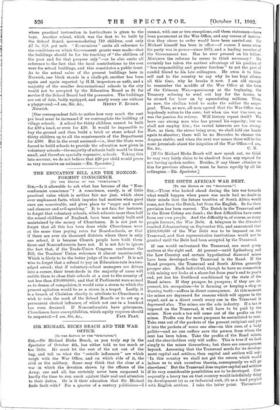THE MONEY VALUE OF THE VOLUNTARY SCHOOLS.
[TO THE EDITOR Or Tits "SPECTATOR."] Sin,--Your correspondent " Economicus " in the Spectator of October 4th would seem to have fallen into the error which is found in the Education Blue-book 1900-1901 when he puts the average cost per seat in an elementary school at £15. The Blue-book average of £14 18s. 7d. includes London, with its extravagantly costly sites and its most costly buildings of all sorts and sizes. In the Blue-book for 1882-83 the average arrived at in the same way for Board-schools was about
212 10s. For the providing of accommodation for 280,146 scholars in 1,572 denominational schools, with 933 teachers' residences, the building or enlarging of which was aided by Government grant, under the conditions of the Education Act of 1870, the amount of grant was 1:312,000, while local contributions, including the value of the sites, totalled £1,348,109. The average cost "per unit" in these schools was then given at £5 7s. per scholar. The actual cost of buildings in Norwich is given in the "Norwich School Board Finance Manual" for 1901 as ranging from .fal Is. 41d. to
213 3s. 3.td. per head without site, from .f.:7 5s. 91d. to 215 16s. 11id. per head with site. (The higher-grade-school buildings for 628 scholars, with virtually the best secondary- school fittings, cost £18 3s. 94d. per head without the site, while the site of 17,505 sq. ft., including compensation to a manufac- turer for loss of light, cost 22,406 7s. 2d., bringing up the cost per head to £22 Oa. 41d.) The average of the 12 elementary schools, with accommodation for 13,443 scholars, was 29 10s. 3d. without the cost of site ; £11 7s. including the cost of site. The most costly provision is in a block of schools for 1,034 children, on an area of nearly 136,000 sq. ft., where there is large provision for instruction in science and art, the schools being distant from the higher-grade school.. Moreover, four of the most costly buildings were only sanctioned by the Education Department when they included large assembly halls, which would not be required in any school in a small town or in a village. An earlier school, having as much accommodation as the most costly buildings, actually cost, with a site of over 138,000 sq. ft., only L9 17s. 'ad. per unit. This site provides large gardens,
where practical instruction in horticulture is given to the boys. Another school, which was the first to be built by the School Board, accommodating 710 children, cost only £7 5s. 9isd. per- unit. " Economicus " omits all reference to the conditions on which Government grants were made—that the buildings should be for the teaching of "the children of the poor and for that purpose only "—as he also omits all reference to the fact that the local contributions to the cost were for school buildings, and this constitutes a public trust. As to the actual value of the present buildings here in Norwich, one block stands in a chalk-pit, another has been again and again reported by H.M. inspectors as unfit, and a majority of the smaller denominational schools in the city would not be accepted by the Education Board as fit for service if the School Board had the possession. The buildings are out of date, badly equipped, and nearly every one without [Our correspondent fails to notice how very much the cost per head must be increased if we contemplate the building of village schools. A school for thirty children cannot be built for 210 a head, or even for 220. It would be impossible to buy the ground and then build a brick or stone school for thirty children up to all the requirements of the Department for 000. But in the event assumed—i.e., that the State were forced to build schools to provide the education now given in voluntary schools—the majority of schools built would be these small, and therefore specially expensive, schools. Taking this into account, we do not believe that £20 per child would prove so very excessive an estimate.—En. Spectator.]











































 Previous page
Previous page